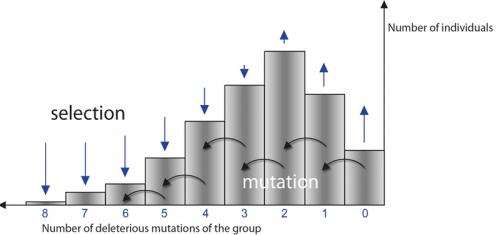Populations survive despite many deleterious mutations: Scientists investigate evolutionary model of Muller's ratchet

From protozoans to mammals, evolution has created more and more complex structures and better-adapted organisms. This is all the more astonishing as most genetic mutations are deleterious. Especially in small asexual populations that do not recombine their genes, unfavourable mutations can accumulate. This process is known as Muller's ratchet in evolutionary biology. The ratchet, proposed by the American geneticist Hermann Joseph Muller, predicts that the genome deteriorates irreversibly, leaving populations on a one-way street to extinction. In collaboration with colleagues from the US, Richard Neher from the Max Planck Institute for Developmental Biology has shown mathematically how Muller's ratchet operates and he has investigated why populations are not inevitably doomed to extinction despite the continuous influx of deleterious mutations.
The great majority of mutations are deleterious. "Due to selection individuals with more favourable genes reproduce more successfully and deleterious mutations disappear again," explains the population geneticist Richard Neher, leader of an independent Max Planck research group at the Max Planck Institute for Developmental Biology in Tübingen, Germany. However, in small populations such as an asexually reproducing virus early during infection, the situation is not so clear-cut. "It can then happen by chance, by stochastic processes alone, that deleterious mutations in the viruses accumulate and the mutation-free group of individuals goes extinct," says Richard Neher. This is known as a click of Muller's ratchet, which is irreversible – at least in Muller's model.
Muller published his model on the evolutionary significance of deleterious mutations in 1964. Yet to date a quantitative understanding of the ratchet's processes was lacking. Richard Neher and Boris Shraiman from the University of California in Santa Barbara have now published a new theoretical study on Muller's ratchet. They chose a comparably simple model with only deleterious mutations all having the same effect on fitness. The scientists assumed selection against those mutations and analysed how fluctuations in the group of the fittest individuals affected the less fit ones and the whole population. Richard Neher and Boris Shraiman discovered that the key to the understanding of Muller's ratchet lies in a slow response: If the number of the fittest individuals is reduced, the mean fitness decreases only after a delay. "This delayed feedback accelerates Muller's ratchet," Richard Neher comments on the results. It clicks more and more frequently.
"Our results are valid for a broad range of conditions and parameter values – for a population of viruses as well as a population of tigers." However, he does not expect to find the model's conditions one-to-one in nature. "Models are made to understand the essential aspects, to identify the critical processes," he explains.
In a second study Richard Neher, Boris Shraiman and several other US-scientists from the University of California in Santa Barbara and Harvard University in Cambridge investigated how a small asexual population could escape Muller's ratchet. "Such a population can only stay in a steady state for a long time when beneficial mutations continually compensate for the negative ones that accumulate via Muller's ratchet," says Richard Neher. For their model the scientists assumed a steady environment and suggest that there can be a mutation-selection balance in every population. They have calculated the rate of favourable mutations required to maintain the balance. The result was surprising: Even under unfavourable conditions, a comparably small proportion in the range of several percent of positive mutations is sufficient to sustain a population.
These findings could explain the long-term maintenance of mitochondria, the so-called power plants of the cell that have their own genome and divide asexually. By and large, evolution is driven by random events or as Richard Neher says: "Evolutionary dynamics are very stochastic."
More information: Richard A. Neher, Boris I. Shraiman: Fluctuations of fitness distributions and the rate of Muller's ratchet. Genetics, Vol. 191, pp. 1283-1293, August 2012. doi:10.1534/genetics.112.141325
Sidhartha Goyal, Daniel J. Balick, Elizabeth R. Jerison, Richard A. Neher, Boris I. Shraiman and Michael M. Desai: Dynamic Mutation-Selection Balance as an Evolutionary Attractor. Genetics, Vol. 191, August 2012. doi: 10.1534/genetics.112.141291
Journal information: Genetics
Provided by Max Planck Society
















